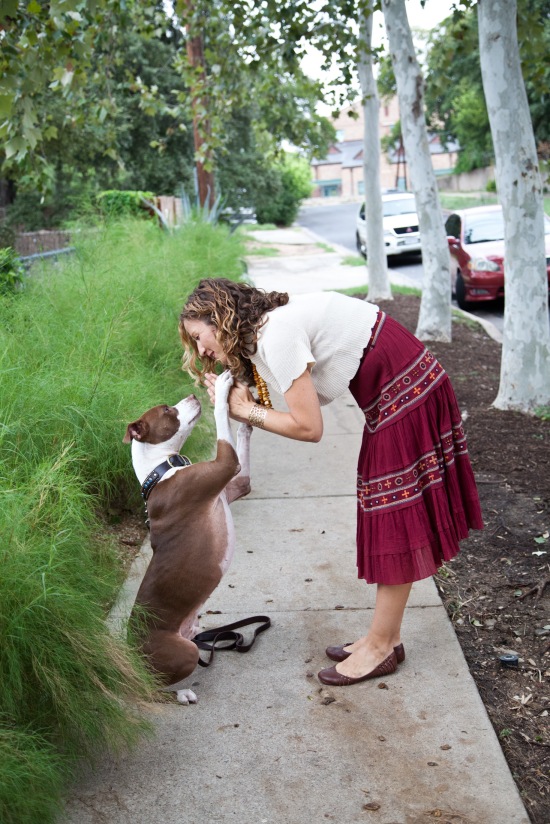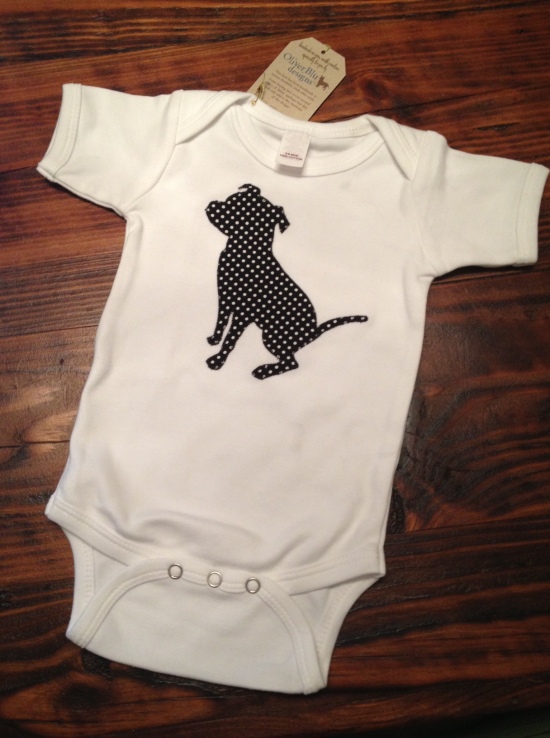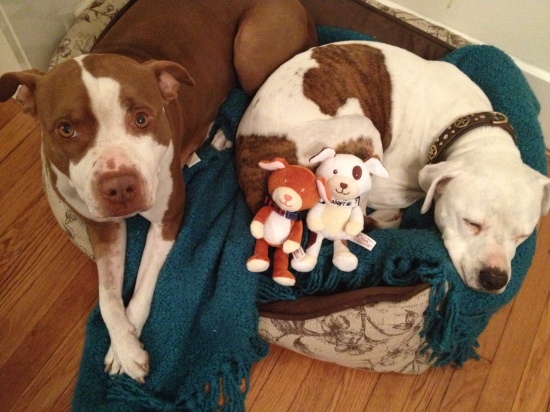In the spirit of continuing to prepare for our new two-legged puppy, we are still collecting brainwashing tools dog-themed gear. Naturally, this continues to be the MOST important preparation that we can make. Just this past week, we’ve acquired this amazing little gift from our dear blog-friend Melvin for our future roommate:
and these adorable stuffed animal versions of ourselves from CharlieDog and Friends:
Meanwhile, mama continues to think about less important things, like our manners.
All in all, we have exquisite house manners. Even mama and dad say so. But that doesn’t mean that mama isn’t making her list (of important manners) and checking it twice, just like Santa would. It does make us wonder though — will we get presents in the chimney if we succeed here?
Here are the major things we’re thinking about.

Mouthiness / Chewing.
One of us (Chick) is not at all a chewer nor a mouthy player, and the other one (Doodlebug) is only a tiny, tiny bit mouthy. So getting this behavior under control isn’t really taking much work, since it already pretty much is under control already (we make mama’s job easy!). But if you are a mouthier dogs — one who chews on things that humans say you shouldn’t, or one that put human fingers in your mouth (either on purpose or by mistake) — you’ll probably want to work on this with your people before your junior resident arrives. It’s pretty easy for grown-up humans to tolerate a little bit of nibbling on the nose or toothiness on the fingers while playing, but we’ve heard that miniature humans are more delicate and it’s easier to make them whimper by mistake. To avoid that in the future, we have been taught from early on that it’s never ok to put our mouths on a human, no matter what. If we’re playing with our people with a toy and one of our teeth lands on their skin (even by accident), the game ends and the toy gets put away. It’s a total bummer, but we sure did learn quickly to be more careful where our teeth land! We also do many many exercises about impulse control, which means “not taking something quickly just because it’s within reach and you reallyreally want it.” So now, mama can be holding a delicious shiny metal thing in her hand with food on the end of it, and even if it is right at mouth-level, we know better than to just run over and steal a lick. Or dad can leave a plate of tater tots on the coffee table, and we know that it is Forbiddish to sneak even a little nibble. Our people say that this is a good habit all around, but that it will come in *extra* handy when our future human shows up and starts leaving his or her yummables carelessly around all over the place.
To satisfy our urges to chew on things but make sure we pick the RIGHT things, mama has made sure to have plenty of chewables in the house. These include nylabones and antlers primarily, plus the occasional raw beef rib or bone section. When we chew on the right things, we get lots and lots of praise and lovings (plus the fun of the chewing to begin with!). When we chew on the wrong things (which is rare), mama just shows us what to chew on *instead.* She also sets us up for success by not leaving tempting-but-illegal chewables laying around, so it’s harder for us to fail. Pretty smart!

Jumping Up
Jumping up on humans is another one of those things that is pretty safe with regular, healthy, sturdy grown-up humans, but can cause a giant case of the uh-ohs with miniature humans. So it’s best to learn way early that it’s never ok to jump up on people, unless invited!
In the photo above, you see me (Doodlebug) putting my paws up on mama, after being invited. Sometimes just coming over for a pat is enough to show her my love, but other times I really want to hold hands and gaze into her eyes. This is why we invented the “say please” trick! Mama puts her hands together and says “say please,” and I know that I am allowed to put my paws up on her arms and give her my sweetest doodle-look! Putting the behavior on cue can be a good way to curb poor judgment, like some dogs have with putting their paws up on humans. We have both struggled with wanting to jump up on people in the past, but now we each have a special cue that a person can give to let us know that it’s ok. Without the cue, we don’t do it.
Usually, dogs jump up on people when they get too excited and forget to mind their manners. In our house, the humans have combatted this by making it a rule that no dog gets greeted unless he’s sitting down — or AT LEAST has four on the floor. We get to practice our good manners at least a couple of times a day, when mama and dad come home from their various dog-free adventurings. When friends and family come over, they are also warned that it is Not Okay to touch or talk to us dogs until we are calm. Early on, it took the elder one of us (Chick) a LONG time to calm down enough to be greeted — sometimes 10-20 minutes! But over time, we have both gotten the hang of it and now greet our people and other people much, much more calmly. We hope our miniature human is impressed with this very important skill that we have!

Barking.
As you can see, one of us is way more of a guard dog than the other. One of us (the whiter one) doesn’t even twitch an eyebrow when the mailman or UPS man comes by, whereas the other (browner) one lets out a little growl for the mailman and a big bow-wow-wow for the UPS guy. Mama hates this, and we are still working on it.
Barking at the doorbell, at people walking by the house, or to demand things (food, games, pettings, to come inside) may seem ok to some folks when they don’t have miniature humans in the house, but once there is a tiny two-legged puppy around who gets woken up from precious sleepy-time by bow-wowing dogs, suddenly it’s not ok. So it’s best to teach a “no barking” rule ahead of time.
We don’t have trouble with barking to demand things or at people, dogs, or squirrels outside the window. But we do have a little bit of an issue with the doorbell, so we are working on it. Early on, mama tried putting a consequence to door-barking (time out). For some dogs (like Chick), this works great. For others, it’s not enough. So now instead, mama is working on teaching us (especially Doodlebug) what to do *instead* of getting worked up with the barks and growls. When mama hears the mail man or FedEx guy coming, she asks for a specific behavior from us — something that will distract us from our door-related frenzy. It’s best if it’s a non-compatible behavior, like running to the dog mat by the BACK door and waiting for a treat. It takes time for this kind of thing to work, and it’s easiest if the bad behavior is preempted, not interrupted. Eventually, when we hear the mailman or UPS guy coming, we will run to the back door all by ourselves to wait for a treat. Pretty cool! At this point this is a work in progress, but mama promises we will get there. Good thing we have started early!
**Note: As several readers have mentioned, it is important for babies to learn to sleep with all kinds of noises going on, so maintaining a silent house should in no way be the goal. But still, times will come up when a loud barking explosion will be unwelcome and disruptive. So it’s best to get the behavior under control sooner than later!**
Place!
There will most certainly be times after our puppy moves in that us dogs just need to not be under foot. Adult humans are clumsy enough (especially our mama lately), but once the people are carrying a puppy around, it’s gonna get downright messy. The puppy might be throwing things, spitting yummables on the floor, and doing who knows what else. So it’s going to be nice for mama and dad to be able to just tell us “go lay down” and know that we will go to our spot. Fortunately, we have been working on this since the beginning, so by now we’re pretty good at it. And we love our special spot so much that we would often rather be there than anywhere else.
But if we weren’t so prepared, here’s how we’d train it. First, mama would pick a spot where she wants us to go hang out by default, and she’d teach us that it should be our favorite spot. She’d do this by giving us All The Good Things there — our pettings and chin scratchings, our chewables, our special snacks, and our praises. Then, she’d start teaching us to go there on cue (we use “go lay down” in our house). Then, she’d help us learn to stay there, because you never know when something good might come to you in your spot (she would bring us random surprise wonderfulnesses while we’re on our spot).
Now we’re at a point where this gets even more complicated. Mama is working on dropping an especially good yummable on the ground near us, and asking us to go to our spot. If we get it right, mama brings us the dropped yummable AND another goodie! Boy, she really is upping the ante!
One more word about dog spots (and I’m not talking about dalmatian superhero spots like my brother has under his furs). As we mentioned last week, it’s important that us dogs have our own spot that is ours alone, and will be protected form the miniature human once it arrives. Even though we all might get along swimmingly, sometimes dogs get tired of little human puppies and need a break. It’s the adult humans’ job to make sure that everybody has their own special place where they can go and hide.
Join us for another installment next week, when we talk about dogs & babies, out & about!


Love this mini series! It’s great even for those of us not yet expecting a human puppy yet!
You probably know this, but as a nanny, I feel responsible for saying it here just in case: Noise during a new baby’s naps is a good thing. Run the vacuum, turn on the tv/radio, ring the phone, talk to yourself, the dogs, Dad. It makes for a good sleeper and it’s something that will last a lifetime. But if the baby only ever gets used to quiet at naptime, it makes for a toddler who doesn’t nap- or worse, someone like me who wakes up at night if a butterfly flaps its wings in Africa.
My dog gives a bark or 2 when someone’s outside, too, and I’ve been working to train it out of her for longer than you’d think necessary (there have been VAST improvements, it’s just not completely gone yet) so I don’t blame you for wanting to end the behavior. I’ll be checking back to see what you do that works!
Totally agree — but with a baby in the house, it seems that there WILL be times that a dog’s bark is inconveniently disruptive.
We are super excited for you all as you wait for the new puppy! Love your series, it’s been super helpful to some of my pregger friends!!
I second what Notyourvictim said: don’t try to maintain a silent house when the baby sleeps, you’ll only set yourself up for frustration and a baby who can only sleep under certain circumstances.
Totally agree — but with a baby in the house, it seems that there WILL be times that a dog’s bark is inconveniently disruptive.
what good info! These are good things for dogs not waiting for puppies to learn too!
This series is fabulous! Lots of material to cover so that dogs and babies live together happily and healthily…as they are meant to!
It’s so cool to follow all the fun and practical preparation you have done to prepare for your two-legged pup! You are setting everyone up for success ahead of time instead of trying to put out fires as they happen. I’m extremely impressed and will definitely be re-reading these posts when (not anytime soon just yet!) I’m thinking of adding a two-legged pup to my crew. Thanks for sharing the process.
Congratulations on your two-legged puppy! Seems like there is quite a bit of that going on in the Blogosphere lately!
Aleks, you’re just so awesome 🙂
Those two leggers like to let us taste everything
Benny & Lily
Glad you’re doing all this prep. But, of course, I’d expect no less.
I’ve been curious about something and I’m wondering if you’re game for it when your new snickerdoodle is old enough–can you clicker train a toddler to handle a dog gently?
I know parents who have taught their pre-verbal toddlers sign language. The idea is that young children sometimes have tantrums because they’re frustrated by not being able to communicate their needs. Since a clicker is an effective tool for communication, why wouldn’t it be a faster way to teach a toddler gentle behavior with dogs?
I know lots of people would find the idea of clicker training a human child tacky but I figured you’d get it. Besides, I’ve seen track and gymnastics coaches using clickers to train youngsters so why not something as important as safe dog handling?
Pamela, This is an interesting question and I don’t doubt that you could achieve some success. I am not a clicker person, though, so you’re going to have to find somebody else to conduct the experiment. I’ll be sure to keep you apprised, though, of how other dog training techniques are working on our junior human / science experiment as time goes on 🙂
I had a question about the dogs staying on their spot when something yummy is falls to the ground. If a dog stays on his spot, he gets a reward of the goodie that dropped plus another goodie. But in the future, let’s say the new baby drops something and the dog stays in his spot. Will he expect to get the thing the baby dropped as well as the treat? Would it be confusing if the dog can’t have what the baby dropped? Is this a silly question? Just wondering…
Hey! Good question. This works similarly to any other training. At first, the dog gets the reward after every single repetition. But eventually, the dog only gets a reward every now and then. The behavior is ingrained by then, though. Dogs aren’t generally doing complex calculations of relative values in their heads in spur-of-the-moment situations, so as long as the dog gets ALL the goodies while this is being trained, he will continue to assume that most times that something falls on the ground and he stays in his spot, he is getting all the good things.
Hope this helps.
Pingback: Ready for baby mini-series: Curious baby-made matters « Love and a Six-Foot Leash
Pingback: Ready for baby mini-series: Out and about! « Love and a Six-Foot Leash
Pingback: Ready for baby mini-series: When it’s go-time! « Love and a Six-Foot Leash
Pingback: Ready for Baby Mini-Series: Resources « Love and a Six-Foot Leash
Pingback: Dogs and baby – the secret to success « Love and a Six-Foot Leash
http://www.bormioliroccousa.com/australia/ugg-black-friday-sale.html ugg black friday sale